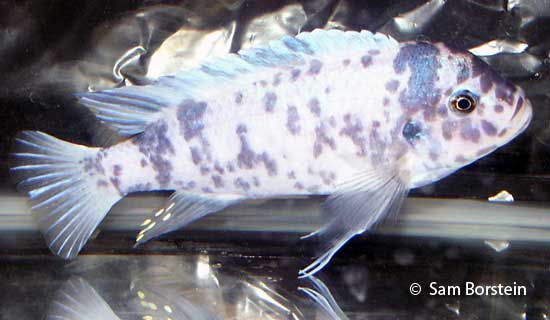Metriaclima sp. "zebra blue"
Blueberry Zebra
Synonyms: Maylandia sp. "zebra blue", Pseudotropheus sp. "zebra blue"

Above: An OB male Metriaclima sp. "zebra blue". Photo by Sam Borstein.
Etymology:
Genus- Metri= average (Latin), clima= slope (Latin).
Species- "zebra blue"= it is blue and similar to Metriaclima zebra.
Intro:
Metriaclima sp. "zebra blue" is a unique mbuna. This undescribed species is considered a species of its own becaue it lacks any black pigmentation, unique among the zebras from Lake Malawi.
There are a two color morphs of this fish:
- Blue- Light Blue Males and Cream colored Females.
- OB- OB males with white body color and OB females with a cream body color.
Distribution:
Metriaclima sp. "zebra blue" is found at Maleri Island, Nankoma Island, and Chidunga Rocks in Lake Malawi around rocks.
Size, Maturity, and Sexual Dimorphism:
Size: Males- 4.5 inches, Females- 4 inches
Maturity: 2.5 inches
Sexual Dimorphism: Sexing is difficult. Males are larger and are either blue or white body colored depending on color morph, while females have a cream body color.
Care:
Metriaclima sp. "zebra blue" is easy to care for. Be sure to give this fish rocks as it is shy, and will feel much more comfortable in a tank with lots of color. This fish in my opinion is not aggressive. I never saw much aggression between males or between males and females.
Diet:
This fish is an herbivore, but will accept some foods with higher protein. A diet of mixed flakes and pellets should do them well.
Breeding:
The Blueberry Zebra was hard to breed. The fish really take a long time to get comfortable to their surroundings. In my opinion, this fish did not spawn often and broods were relatively small at about 12 fry per spawn. Females were poor holders and I stripped them after a week and raised the eggs and fry artificially.
Fry are easy to raise and are average size for the genus. They accept baby brine shrimp or crushed flake as a first food. They do take some time until they begin to develop the pretty blue blotched pattern of the adults.
Conclusion:
The Blueberry Zebra is just another Zebra type. Nothing is special about this fish other than the lack of black pigmentation. This fish is popular among hobbyists and is sometimes even seen in pet shops.
References:
- Konings, A. (2007) Malawi cichlids in their natural habitat. 4th ed., Cichlid Press, El Paso, Texas, 424 pp.
